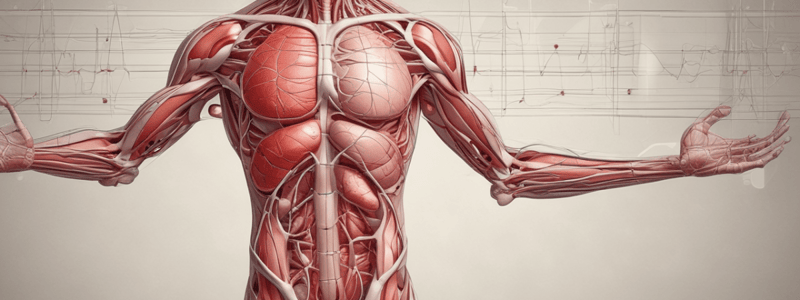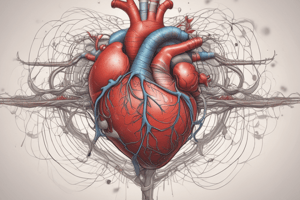Podcast
Questions and Answers
What is the main function of capillaries in the blood circulatory system?
What is the main function of capillaries in the blood circulatory system?
- To regulate blood pressure
- To store oxygenated blood
- To pump blood towards the heart
- To facilitate gas and nutrient exchange between the blood and surrounding tissues (correct)
What type of muscle is found in the walls of arterioles?
What type of muscle is found in the walls of arterioles?
- Voluntary muscle
- Smooth muscle (correct)
- Cardiac muscle
- Skeletal muscle
What is unique about the pulmonary arteries compared to other arteries?
What is unique about the pulmonary arteries compared to other arteries?
- They carry oxygenated blood
- They are the smallest of all blood vessels
- They are found only in the heart
- They carry deoxygenated blood from the heart to the lungs (correct)
What is the purpose of the one-way valves in veins?
What is the purpose of the one-way valves in veins?
What happens to the blood as it leaves the capillaries?
What happens to the blood as it leaves the capillaries?
What is the main difference between the walls of arteries and veins?
What is the main difference between the walls of arteries and veins?
What is the role of the right ventricle of the heart in the oxygenation process?
What is the role of the right ventricle of the heart in the oxygenation process?
What is the function of the pulmonary veins?
What is the function of the pulmonary veins?
What type of tissue is found in the walls of the aorta?
What type of tissue is found in the walls of the aorta?
What is the main function of the vena cava?
What is the main function of the vena cava?
What is the purpose of the prothrombin time test?
What is the purpose of the prothrombin time test?
What is the function of the coronary sinus?
What is the function of the coronary sinus?
What is the difference between the superior and inferior vena cava?
What is the difference between the superior and inferior vena cava?
What is the purpose of the baroreceptors in the aorta?
What is the purpose of the baroreceptors in the aorta?
What is the function of the middle cardiac vein?
What is the function of the middle cardiac vein?
What type of blood vessels do arterioles branch into?
What type of blood vessels do arterioles branch into?
What is the primary function of the capillaries?
What is the primary function of the capillaries?
Which of the following statements is true about veins?
Which of the following statements is true about veins?
What type of cells make up the walls of capillaries?
What type of cells make up the walls of capillaries?
Why do veins have thinner walls compared to arteries?
Why do veins have thinner walls compared to arteries?
What is the direction of blood flow in veins?
What is the direction of blood flow in veins?
What is unique about the pulmonary arteries?
What is unique about the pulmonary arteries?
What is the role of the left atrium in the oxygenation process?
What is the role of the left atrium in the oxygenation process?
What is the primary function of the elastic tissue in the walls of the aorta?
What is the primary function of the elastic tissue in the walls of the aorta?
What is the final destination of oxygenated blood in the heart?
What is the final destination of oxygenated blood in the heart?
What is the purpose of the muscular arteries in the circulatory system?
What is the purpose of the muscular arteries in the circulatory system?
What is the result of the coagulation cascade process?
What is the result of the coagulation cascade process?
What is the difference between the superior and inferior vena cava?
What is the difference between the superior and inferior vena cava?
What is the role of the coronary sinus in the heart's circulatory system?
What is the role of the coronary sinus in the heart's circulatory system?
What is the purpose of the PT test in blood clotting?
What is the purpose of the PT test in blood clotting?
Flashcards are hidden until you start studying
Study Notes
Blood Circulation
- Blood leaves the heart and enters arteries, which are large blood vessels with elastic walls containing smooth muscle.
- Arteries branch into arterioles, which are smaller and have less elastic walls, but still contain smooth muscle that can contract or relax to control blood flow.
- Arterioles lead to a network of capillaries, the smallest blood vessels, where gas and nutrient exchange occurs between the blood and surrounding tissues.
- Deoxygenated blood leaves the capillaries and enters venules, which join together to form larger veins that carry blood back to the heart.
Pulmonary Circulation
- Deoxygenated blood is propelled from the heart to the lungs through the pulmonary arteries.
- Oxygen is picked up from the capillary beds of the lungs, and freshly oxygenated blood returns to the left atrium of the heart through the pulmonary veins.
Arterial System
- Arteries carry blood away from the heart, while veins bring blood back to the heart.
- The aorta is the largest artery in the body and is an elastic artery that stretches to accommodate blood flow.
Venous System
- Veins carry deoxygenated blood back to the heart, with thinner walls and one-way valves to prevent blood from flowing backwards.
- The superior and inferior vena cava are large veins that collect blood from above and below the diaphragm, respectively, and return it to the right atrium.
Blood Clotting
- Prothrombin time (PT) is a test that measures the time it takes for blood to produce a thrombus or blood clot.
- PT evaluates the levels of clotting factors in plasma, which are used in the coagulation cascade process to form fibrin and complete clot formation.
Heart's Circulatory System
- The superior and inferior vena cava return deoxygenated blood to the heart, which is then re-oxygenated and circulated back to the body.
- The heart has its own circulatory system, which includes the middle cardiac vein and coronary sinus, to supply oxygenated blood and remove deoxygenated blood.
Blood Circulation
- Blood leaves the heart and enters arteries, which are large blood vessels with elastic walls containing smooth muscle.
- Arteries branch into arterioles, which are smaller and have less elastic walls, but still contain smooth muscle that can contract or relax to control blood flow.
- Arterioles lead to a network of capillaries, the smallest blood vessels, where gas and nutrient exchange occurs between the blood and surrounding tissues.
- Deoxygenated blood leaves the capillaries and enters venules, which join together to form larger veins that carry blood back to the heart.
Pulmonary Circulation
- Deoxygenated blood is propelled from the heart to the lungs through the pulmonary arteries.
- Oxygen is picked up from the capillary beds of the lungs, and freshly oxygenated blood returns to the left atrium of the heart through the pulmonary veins.
Arterial System
- Arteries carry blood away from the heart, while veins bring blood back to the heart.
- The aorta is the largest artery in the body and is an elastic artery that stretches to accommodate blood flow.
Venous System
- Veins carry deoxygenated blood back to the heart, with thinner walls and one-way valves to prevent blood from flowing backwards.
- The superior and inferior vena cava are large veins that collect blood from above and below the diaphragm, respectively, and return it to the right atrium.
Blood Clotting
- Prothrombin time (PT) is a test that measures the time it takes for blood to produce a thrombus or blood clot.
- PT evaluates the levels of clotting factors in plasma, which are used in the coagulation cascade process to form fibrin and complete clot formation.
Heart's Circulatory System
- The superior and inferior vena cava return deoxygenated blood to the heart, which is then re-oxygenated and circulated back to the body.
- The heart has its own circulatory system, which includes the middle cardiac vein and coronary sinus, to supply oxygenated blood and remove deoxygenated blood.
Studying That Suits You
Use AI to generate personalized quizzes and flashcards to suit your learning preferences.




